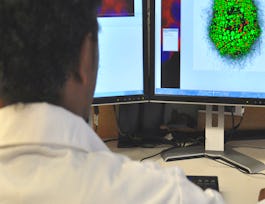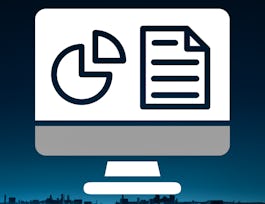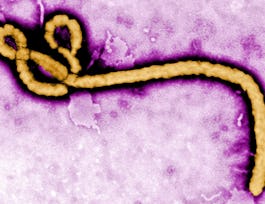Antimicrobial resistance is an increasingly pressing global concern. This course offers unique and comprehensive insights into the challenges posed by AMR, exploring its mechanisms, implications for public health and laboratory methods as well as tools for identification.



Antimicrobial resistance - theory and methods



Instructors: Lina Cavaco
Sponsored by Coursera Learning Team
68,337 already enrolled
(2,407 reviews)
Recommended experience
What you'll learn
Prepare for a career with our Intermediate level course in understanding AMR.
Apply new skills to projects and portfolio.
Learn and develop in demand skills and relevant knowledge for identification of AMR and laboratory methods.
Learn the most up-to-date theoretical & practical skills in antimicrobial resistance identification and testing.
Details to know

Add to your LinkedIn profile
7 assignments
See how employees at top companies are mastering in-demand skills


Earn a career certificate
Add this credential to your LinkedIn profile, resume, or CV
Share it on social media and in your performance review

There are 8 modules in this course
This module is a welcome to the course where you can find information on the course structure, the content that you will be introduced to in the next modules, the grading, as well as an introduction to the instructors and the teaching material.
What's included
1 video1 reading
In this module you will learn about antibiotics/ antimicrobials and you will get to know more about what they are, where they come from, what are the major groups and how can we classify them, as well as how do they have an effect and how do they act on the bacterial cells.
What's included
2 videos1 assignment
This module contains information about antimicrobials and the development of resistance in bacteria including causes for resistance and their mechanisms, as well as an insight in how resistance disseminates and how it can be selected.
What's included
4 videos1 assignment
This module deals with antimicrobial susceptibility testing in the laboratory: its importance and use, descriptions of the methods and their applications and detailed descriptions of the procedures applied for the main methods. Additionally, this module gives practical insight on how to interpret antimicrobial susceptibility results.
What's included
9 videos2 assignments
As alternative to the phenotypical methods, the researcher might decide to use genotypically based methods to identify genes of interest. In the lectures of this module we present the ResFinder tool which may be used to find resistance mechanisms ( genes and in the future versions also specific point mutations) from Whole genome sequences of bacteria of interest. The second lecture is a demonstration of the MyDBFinder which can be used to identify genes of interest defined by the user from Whole genome sequence data. DISCLAIMER: There has been a change since the ResFinder video lecture was prepared – and there is now only one ResFinder web-tool available: http://genepi.food.dtu.dk/resfinder . This version of the ResFinder automatically includes both the ResFinder and PointFinder databases .
What's included
2 videos1 assignment
This module is dedicated to Quality management and Quality assurance (QA)/ Quality control (QC) procedures and use of QC strains to assure the quality of results of antimicrobial susceptibility testing: importance, elements and principles.
What's included
2 videos1 assignment
The module provides an in-depth understanding of critical important antimicrobials (CIA). You will explore the importance of CIAs, the mechanism of action and the challenges associated.
What's included
5 videos1 assignment
In this module, you will explore AMR integrated surveillance systems at local, regional, and global levels, emphasizing the One Health approach. Specific discussions will include national and regional surveillance initiatives like DANMAP, as well as presentations on FAO InFARM, WHO GLASS, and WHO MIA (CIA).
What's included
6 videos
Instructors



Offered by
Why people choose Coursera for their career




Learner reviews
2,407 reviews
- 5 stars
74.31%
- 4 stars
21.32%
- 3 stars
3.77%
- 2 stars
0.29%
- 1 star
0.29%
Showing 3 of 2407
Reviewed on Aug 30, 2020
I would personally recommend this course to any student aiming for a brief introduction to antimicrobial resistance and also to anyone looking for a very nice and quick brushup of the concepts.
Reviewed on Sep 26, 2020
Though it was an intermediate course, I found it easy enough to keep up with the microbiological terminology used and the themes being explained. It was a good and informative course.
Reviewed on Sep 27, 2020
I wish to thank all the Professors and happy i took the course.Well taught.Easy explanation and made easy. New things learnt. Hope more will be conducted with the latest .
Recommended if you're interested in Health

Icahn School of Medicine at Mount Sinai

University of Toronto

Universiteit Leiden

Emory University

Open new doors with Coursera Plus
Unlimited access to 10,000+ world-class courses, hands-on projects, and job-ready certificate programs - all included in your subscription
Advance your career with an online degree
Earn a degree from world-class universities - 100% online
Join over 3,400 global companies that choose Coursera for Business
Upskill your employees to excel in the digital economy


